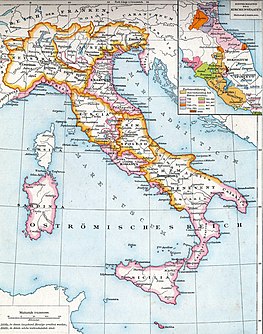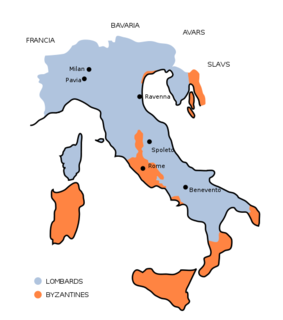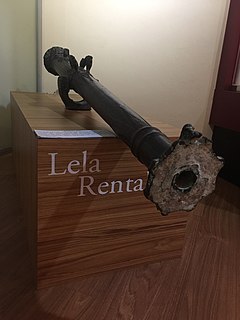
A cannon is a large-caliber gun classified as a type of artillery, and usually launches a projectile using explosive chemical propellant. Gunpowder was the primary propellant before the invention of smokeless powder during the late 19th century. Cannons vary in gauge, effective range, mobility, rate of fire, angle of fire and firepower; different forms of cannon combine and balance these attributes in varying degrees, depending on their intended use on the battlefield. A cannon is a type of heavy artillery weapon.

The Lombards or Langobards were a Germanic people who ruled most of the Italian Peninsula from 568 to 774, with origins near the Elbe in northern Germany and Scania in southern Sweden before the Migration Period.

Carole Lombard was an American actress, particularly noted for her energetic, often off-beat roles in screwball comedies. In 1999, the American Film Institute ranked Lombard 23rd on its list of the greatest female stars of Classic Hollywood Cinema.

Pavia is a town and comune of south-western Lombardy in northern Italy, 35 kilometres south of Milan on the lower Ticino river near its confluence with the Po. It has a population of c. 73,086. The city was the capital of the Kingdom of the Lombards from 572 to 774.
The term Lombard refers to people or things related to Lombardy, a region in northern Italy.

Lombard is a village in DuPage County, Illinois, United States, and a suburb of Chicago. The population was 43,165 at the 2010 census. The United States Census Bureau estimated the population in 2019 to be 44,303.

Bank and Monument are interlinked London Underground and Docklands Light Railway (DLR) stations that form a public transport complex spanning the length of King William Street in the City of London. Bank station, named after the Bank of England, opened in 1900 at Bank junction and is served by the Central, Northern and Waterloo & City lines, and the DLR. Monument station, named after the Monument to the Great Fire of London, opened in 1884 and is served by the District and Circle lines. The stations have been linked as an interchange since 1933.

Cividale del Friuli is a town and comune in the Province of Udine, part of the North-Italian Friuli Venezia Giulia regione. The town lies 135 metres (443 ft) above sea-level in the foothills of the eastern Alps, 15 kilometres (9 mi) by rail from the city of Udine and close to the Slovenian border. It is situated on the river Natisone, which forms a picturesque ravine here. Formerly an important regional power, it is today a quiet, small town that attracts tourists thanks to its medieval center.

Lombard is Gallo-Romance language, consisting in a linguistic continuum spoken by millions of speakers in Northern Italy and Southern Switzerland, including most of Lombardy and some areas of neighbouring regions, notably the eastern side of Piedmont and the western side of Trentino, and in Switzerland in the cantons of Ticino and Graubünden.
Milanese is the central variety of the Western dialect of the Lombard language spoken in Milan, the rest of its metropolitan city, and the northernmost part of the province of Pavia. Milanese, due to the importance of Milan, the largest city in Lombardy, is considered one of the most prestigious Lombard variants and the most prestigious one in the Western Lombard area.

Ten Little Indians is a 1965 British crime mystery film directed by George Pollock. It is the second film version of Agatha Christie's 1939 novel. It was produced by Oliver A. Unger, with co-producer Harry Alan Towers also credited as co-writer under his pen name Peter Welbeck.

And Then There Were None is a 1974 film adaptation of Agatha Christie's best-selling 1939 mystery novel of the same name. The film was directed by Peter Collinson and produced by Harry Alan Towers. This was the second of three versions of Christie's novel to be adapted to the screen by producer Harry Alan Towers. Two film adaptations were previously released. An American made-for-television version was broadcast in 1959. Towers produced a third version in 1989.

Lantaka or rentaka was a type of bronze portable cannon or swivel gun, sometimes mounted on merchant vessels and warships in Maritime Southeast Asia. It was commonly equipped by native seafaring vessels from Indonesia, Philippines, Brunei, and Malaysia. Lela and rentaka are known by the Malays as meriam kecil, the difference is that rentaka is smaller in length and bore than a lela.

The Kingdom of the Lombards also known as the Lombard Kingdom; later the Kingdom of (all) Italy, was an early medieval state established by the Lombards, a Germanic people, on the Italian Peninsula in the latter part of the 6th century. The king was traditionally elected by the very highest-ranking aristocrats, the dukes, as several attempts to establish a hereditary dynasty failed. The kingdom was subdivided into a varying number of duchies, ruled by semi-autonomous dukes, which were in turn subdivided into gastaldates at the municipal level. The capital of the kingdom and the center of its political life was Pavia in the modern northern Italian region of Lombardy.

Iskandar Muda was the twelfth Sulṭān of Acèh Darussalam, under whom the sultanate achieved its greatest territorial extent, and was the strongest power and wealthiest state in the western Indonesian archipelago and the Strait of Malacca. "Iskandar Muda" literally means "young Alexander," and his conquests were often compared to those of Alexander the Great. In addition to his notable conquests, during his reign, Aceh became known as an international centre of Islamic learning and trade. He was the last Sultan of Aceh from male descendant of Ali Mughayat Syah as the founder and the first Sultan of Aceh Sultanate. Iskandar Muda's death meant that the founding dynasty of Aceh Sultanate, the House of Meukuta Alam died out and was replaced by other dynasty.

Bradshaw Crandell was an American artist and illustrator. He was known as the "artist of the stars". Among those who posed for Crandell were Carole Lombard, Bette Davis, Judy Garland, Veronica Lake and Lana Turner. In 1921 he began his career with an ad for Lorraine hair nets sold exclusively by F. W. Woolworth. His first cover illustration was the May 28, 1921 issue for the humor magazine Judge. In later life he went from illustrations to oil-on-canvas paintings which included political figures. He also provided poster work for 20th Century Fox. In 2006 he was inducted into the Society of Illustrators hall of fame. In March 2010, an illustration for the 1952 Dutch Treat Club yearbook of Crandell's sold for $17,000.

Lombard Street is a street notable for its connections with the City of London's merchant, banking and insurance industries, stretching back to medieval times.

The Cetbang refers to cannons produced and used by the Majapahit Empire (1293–1527) and other kingdoms in the Indonesian archipelago. There are 2 main types of cetbang: the eastern-style cetbang which looks like a Chinese cannon and is loaded from the front, and the western-style cetbang which is shaped like a Turkish and Portuguese cannon, loaded from the back.

Lela or lila is a type of Malay cannon, used widely in the Nusantara archipelago. They are similar to a lantaka but longer and had larger bore. Lela can be configured as swivel gun, fixed gun, or mounted in a gun carriage. It is the equivalent of European falcon and falconet.















